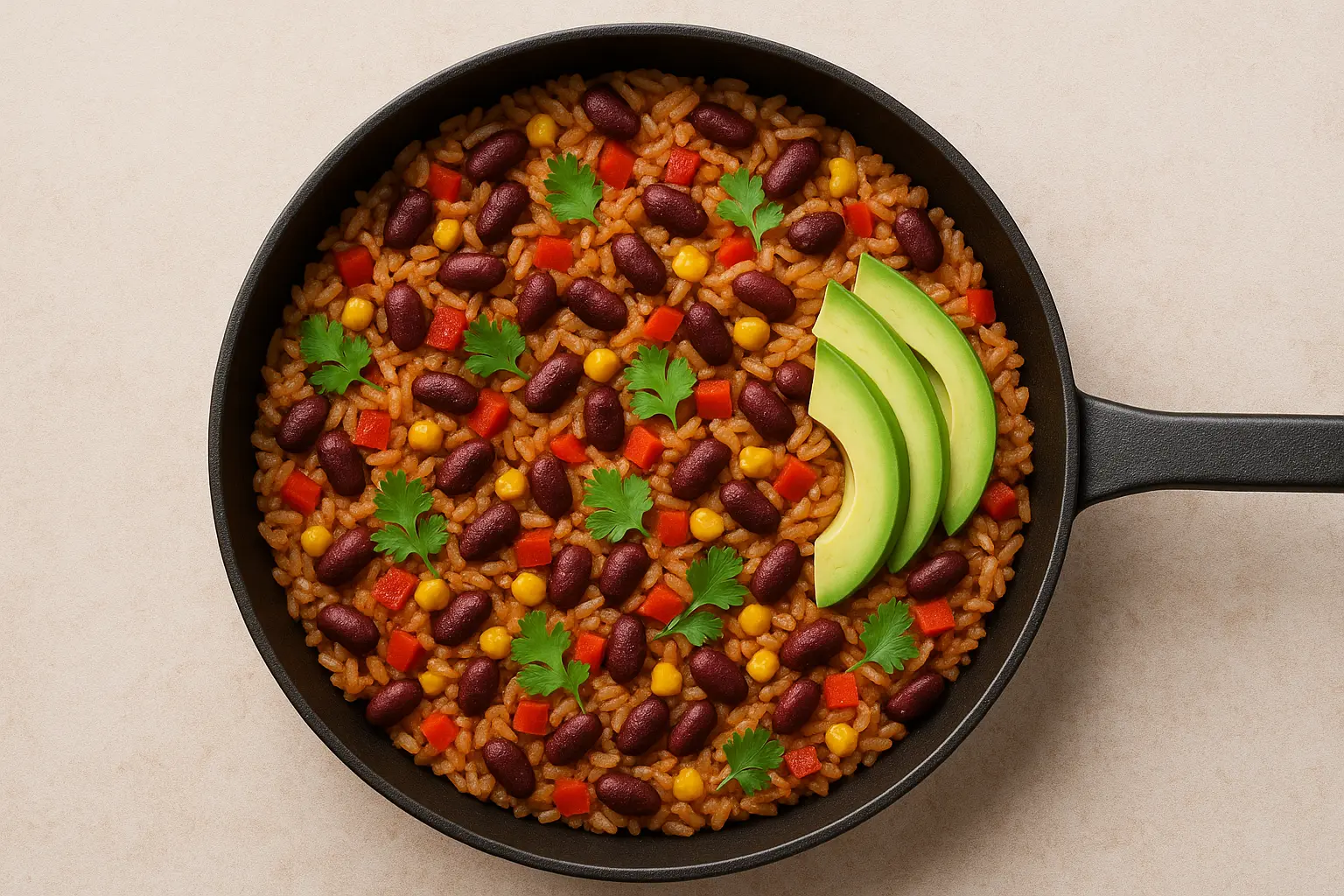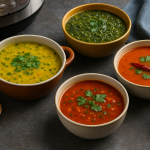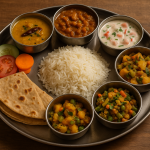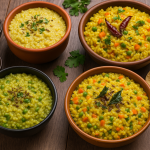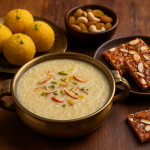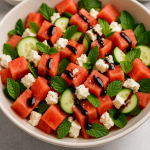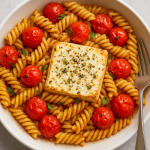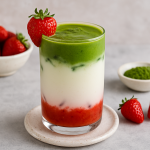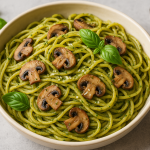There’s something undeniably satisfying about a bowl of noodles. Whether you slurp them from a street-side stall in Seoul or from your kitchen table in Sydney, noodles deliver instant comfort. But when it comes to flavour that hits all the notes — sweet, savoury, spicy, and umami — Korean gochujang noodles take the crown.
Gochujang, a fermented red chili paste, is the heart and soul of this recipe. It’s the ingredient that transforms an ordinary noodle dish into something fiery, complex, and deeply satisfying. These Spicy Korean Gochujang Noodles are a fusion of heat and harmony — a simple, quick meal that’s vegan, budget-friendly, and deliciously addictive.
Whether you’re a seasoned Korean food lover or new to Asian cooking, this recipe delivers authentic flavour with minimal effort. All you need is a few pantry staples, some noodles, and about 20–25 minutes.
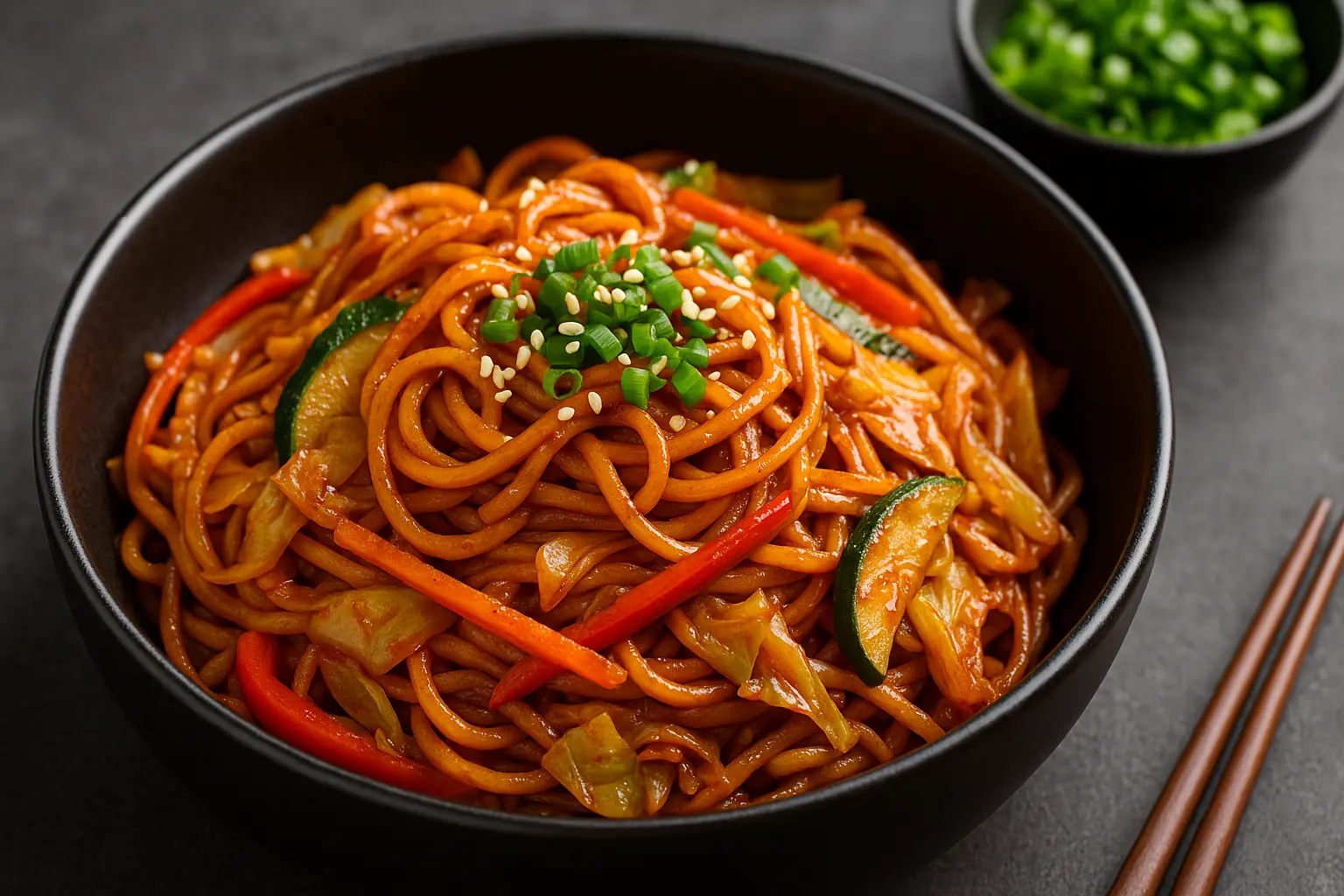
What Makes Gochujang So Special?
Before diving into the recipe, let’s talk about the star ingredient: gochujang. This deep red paste, a staple in Korean kitchens, is made from red chili powder, fermented soybeans, glutinous rice, and salt. The fermentation process gives it a complex profile — simultaneously spicy, sweet, and umami-rich.
Here’s why it’s magic in noodle dishes:
- Depth of flavour: It adds more than just heat; it brings smokiness and subtle sweetness.
- Fermentation: The umami from fermented soybeans creates that “savoury punch” that makes food taste complete.
- Versatility: It pairs beautifully with noodles, rice, tofu, meats, and vegetables.
You can find gochujang in most Asian grocery stores or online. It usually comes in small tubs or squeeze bottles — and a little goes a long way.
Ingredients You’ll Need
This recipe is flexible and forgiving — perfect for using what you already have in your kitchen. Here’s what you’ll need:
For the Noodles
- 250g wheat noodles, ramen, soba, or rice noodles
- 1 tablespoon sesame oil
- 1 teaspoon salt (for boiling water)
For the Gochujang Sauce
- 2 tablespoons gochujang (adjust to your spice preference)
- 1 tablespoon soy sauce
- 1 tablespoon rice vinegar
- 1 tablespoon brown sugar or maple syrup
- 1 teaspoon toasted sesame oil
- 2 cloves garlic, minced
- 1 teaspoon grated ginger
- ¼ cup water (to loosen the sauce)
For the Stir-Fry
- 1 tablespoon neutral oil (like canola or avocado oil)
- ½ red capsicum, thinly sliced
- ½ carrot, julienned
- ½ zucchini, sliced
- 1 small onion, sliced
- 1 cup shredded cabbage (optional but great for crunch)
- ½ cup firm tofu or tempeh cubes (for protein)
Toppings (Optional but Highly Recommended)
- Toasted sesame seeds
- Finely chopped spring onions
- A drizzle of sesame oil
- Nori strips or crushed roasted seaweed
- Lime wedges for brightness
Step-by-Step Recipe Instructions
1. Cook the Noodles
Boil a large pot of salted water. Cook your noodles according to the package directions until they’re al dente — chewy but tender. Drain and toss them with a drizzle of sesame oil to prevent sticking. Set aside.
Tip: Korean wheat noodles or ramen noodles give the best chewy texture, but rice noodles work beautifully for gluten-free versions.
2. Prepare the Gochujang Sauce
In a small bowl, whisk together:
- Gochujang
- Soy sauce
- Rice vinegar
- Brown sugar or maple syrup
- Sesame oil
- Minced garlic and ginger
- Water
Taste and adjust: If it’s too spicy, add a bit more sugar or water; if too sweet, add an extra splash of soy sauce. The consistency should be smooth and pourable, not too thick.
3. Stir-Fry the Veggies
Heat oil in a wok or large pan over medium-high heat. Add onion, garlic, and ginger first; sauté until fragrant. Then add the capsicum, carrot, zucchini, and cabbage. Stir-fry for 3–4 minutes — the vegetables should stay slightly crisp.
If you’re using tofu or tempeh, add them now and let them brown slightly for extra texture.
4. Combine Everything
Lower the heat to medium. Pour in the gochujang sauce and stir well. Let it simmer for about 2 minutes so the flavours meld. Then add the cooked noodles directly into the pan.
Toss continuously with tongs or chopsticks until the noodles are evenly coated with the sauce and heated through. Everything should look glossy and vibrant.
5. Garnish and Serve
Transfer the noodles to bowls and top with:
- A sprinkle of sesame seeds
- Chopped spring onions
- A drizzle of sesame oil
- Optional: seaweed strips or lime juice for a zingy finish
Serve hot — preferably with chopsticks and maybe a cold drink to tame the heat!
Cooking Tips & Variations
Adjusting the Spice Level
If you love heat, add an extra spoonful of gochujang or a pinch of Korean red chili flakes (gochugaru). For milder palates, reduce gochujang to 1 tablespoon and add more soy sauce or sugar.
Protein Options
- Vegan: Use tofu, tempeh, or seitan.
- Non-Vegan: Add stir-fried chicken, prawns, or even a fried egg on top for a Korean-style twist.
- High-protein meal prep: Combine tofu and edamame for a complete protein boost.
Vegetable Swaps
This recipe is incredibly flexible — you can use whatever’s seasonal or on hand:
- Broccoli or baby corn
- Bok choy or spinach
- Mushrooms (shiitake adds extra umami)
- Bean sprouts for freshness
Make it Gluten-Free
Use gluten-free tamari instead of soy sauce and rice noodles instead of wheat noodles.
Why You’ll Love These Gochujang Noodles
- Quick and Easy: Ready in under 30 minutes — ideal for weeknight dinners.
- Customisable: Works with any vegetables or proteins.
- Budget-Friendly: Uses simple pantry staples.
- Vegan-Friendly: Naturally plant-based with loads of flavour.
- Meal-Prep Friendly: Reheats well for lunch the next day.
It’s the kind of recipe that proves fast food can be wholesome, exciting, and deeply satisfying.
The Science of Perfect Noodles
Great noodles aren’t just about the sauce — texture matters just as much. Here’s a quick guide to achieving restaurant-quality results:
- Use slightly undercooked noodles: They’ll continue cooking in the sauce.
- Coat them in oil after boiling: Prevents clumping and helps the sauce stick better.
- Add noodles last: Keeps the veggies crisp and the sauce flavourful.
- Balance your elements: Gochujang brings spice and umami; sugar adds sweetness; vinegar adds brightness; soy adds salt; sesame oil brings aroma.
This balance is what makes Korean noodle dishes so irresistible — every bite has contrast, texture, and harmony.
Nutritional Breakdown (Approx. per serving)
| Component | Amount |
|---|---|
| Calories | ~420 kcal |
| Protein | 12g |
| Fat | 14g |
| Carbohydrates | 58g |
| Fibre | 6g |
| Sodium | 950mg |
Tip: For a lighter version, reduce oil and add more vegetables. You can also use konjac or soba noodles to cut carbs.
Serving Suggestions
These noodles are versatile enough to pair with many sides and accompaniments:
- Korean Kimchi: The classic pairing — adds tang and crunch.
- Cucumber Salad: A refreshing counter to the spice.
- Miso Soup or Seaweed Soup: Complements the deep umami flavours.
- Pan-Fried Dumplings (Mandu): Perfect for a hearty meal combo.
If you’re making this for guests, serve family-style — everyone can mix and match toppings.
Make-Ahead & Storage Tips
- Refrigerate: Store in an airtight container for up to 3 days.
- Reheat: Use a splash of water and reheat on the stovetop or microwave to loosen the sauce.
- Freeze: You can freeze it for up to a month, but note that the texture may soften slightly upon thawing.
Exploring the Korean Pantry
Cooking more Korean dishes at home? Stock your pantry with these essentials:
- Gochujang: The hero of this dish — spicy, sweet, and fermented.
- Gochugaru: Korean red chili flakes, milder than standard chili powder.
- Soy Sauce: Use a light Korean soy sauce for seasoning (guk ganjang) or dark soy sauce for depth.
- Sesame Oil: For finishing, not cooking — adds nutty aroma.
- Rice Vinegar: Balances spicy and salty flavours.
- Kimchi: A probiotic, spicy fermented side that enhances everything.
Once you have these, Korean-style meals become quick and effortless.
Cultural Insight: Gochujang Beyond Noodles
Gochujang isn’t just for noodles. In Korea, it’s a cornerstone of daily cuisine:
- Used in Bibimbap, a mixed rice dish with vegetables and egg.
- Featured in Tteokbokki, chewy rice cakes in spicy sauce.
- Blended into Korean BBQ marinades for chicken, pork, or beef.
It’s often described as “the taste of Korea” — a symbol of depth, warmth, and boldness. That’s why this noodle dish feels both comforting and exciting, no matter where you eat it.
Common Mistakes to Avoid
- Overcooking the noodles: Always taste them early. Soft noodles won’t hold sauce well.
- Skipping sugar: It’s essential for balance — without it, the sauce may taste too salty or acidic.
- Adding too much water: The sauce should coat the noodles, not pool at the bottom.
- Not tasting as you go: Gochujang brands differ in spice and salt level — adjust accordingly.
Add a Fusion Twist
Want to mix things up? Try these creative variations:
- Creamy Gochujang Pasta: Add coconut milk or oat cream for a spicy-creamy fusion sauce.
- Gochujang Stir-Fry Udon: Use thick udon noodles for a chewy, comforting meal.
- Gochujang Fried Rice: Use leftover sauce with rice instead of noodles.
- Gochujang Peanut Noodles: Blend a spoon of peanut butter into the sauce for nutty richness.
Each variation offers a new texture and taste while staying true to the core Korean flavours.
The Perfect Pairing Drink
Pair your spicy gochujang noodles with:
- Iced barley tea (boricha): Traditional Korean beverage that cools the palate.
- Lemon or cucumber water: Simple and refreshing to balance the spice.
- Chilled lager or soju: If you’re in the mood for something stronger — both complement the heat perfectly.
Why This Recipe Works for Every Lifestyle
- For Vegans: 100% plant-based.
- For Busy Professionals: Ready in under 30 minutes.
- For Students: Cheap, filling, and easy to cook in a small kitchen.
- For Families: Kids can enjoy a milder version by adjusting spice.
It’s one of those dishes that unites everyone at the table — spicy enough for adults, adaptable enough for everyone else.
Conclusion: A Spicy, Satisfying Meal You’ll Make Again and Again
Spicy Korean Gochujang Noodles are everything a perfect meal should be — fast, flavourful, flexible, and utterly comforting. Whether you’re craving a late-night bite or planning a casual dinner, this dish delivers that unmistakable Korean warmth and zest.
It’s the kind of recipe that proves simple ingredients can create extraordinary flavour. Once you’ve tried it, you’ll find yourself coming back to it again and again — tweaking, experimenting, and mastering it your way.
So next time your taste buds crave something bold and fiery, reach for that tub of gochujang and whip up this easy, spicy bowl of happiness.
Leave a comment
Your email address will not be published. Required fields are marked *




